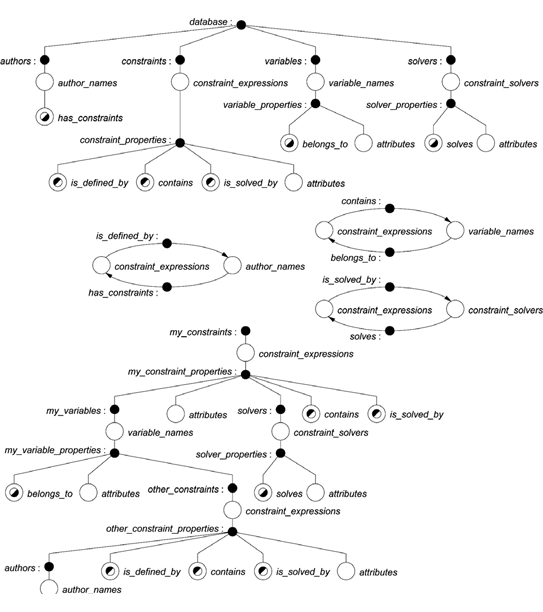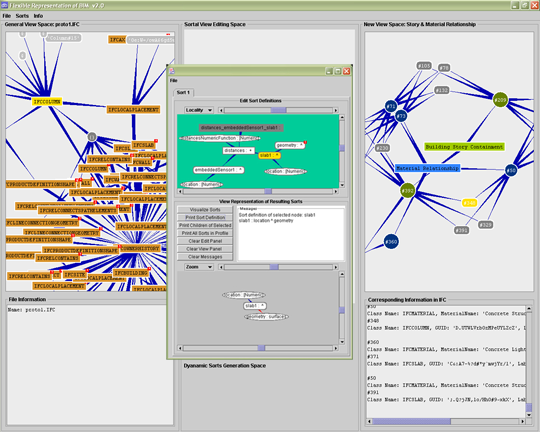| sorts: a concept for representational flexibility |
1996-present |
In collaboration with Rudi Stouffs, Delft University of Technology
Work on Sorts was funded in part by the National Science Foundation (NSF-CMS-0121549)
Rudi Stouffs was funded by Netherlands Organization for Scientific Research (NWO)
project website: http://homepages.ipact.nl/~stouffs/rudi/research/sorts/
Two distinct notions inspired the idea for Sorts: the first, a talk by Chuck Eastman on information coverage between distinct representational schemes in the same domain, and the other, the need to deal with weighted shapes.
| Sorts |
- Provide a semi-constructive algebraic formalism for design representations that enables these to be compared with respect to scope and coverage.
- Present a uniform approach to dealing with and manipulating data constructs.
- Offer representations specified by formal compositional relationships over primitive data types.
|
Formalism allows for dynamic information entities; enables creative design by supporting re-interpretations of existing design descriptions through emergent forms; and considers a methodology for dealing with such dynamism within a design application; that is, it offers representational flexibility.
Sortal descriptions are data structure representations based on sorts.
|
First practical application of sorts was developed in the context of a project building a toolset for the virtual AEC industry, in particular, integrating a numerical constraint solver in a document-centric collaboration environment. |
 |

Sorts depicting a database view (above) and a user view (below) represent design information in the form of design constraints and related information. Property sorts (middle) represent the various links between the constraint expressions and, respectively, the author names, variable names, and constraint solvers.
Sorts in the context of building construction, within a larger project that investigates ways of integrating suites of emerging evaluation technologies to help find, record, manage, and limit the impact of construction defects.

 |
|

different representational needs on a slab |
Using sorts to solve problems
 |
|
Shows networks for utilities, m and n. Each straightline length of pipe is identified by its network utility name, and numbered 1, 2, 3, . . . Gray circles indicate pipe intersections; of these, the darker circles signify possible interference.
An easy way to solve the design problem is to define exogenously, a “view” of labeled points of intersection as follows: each such point is associated with labels identifying the pipes’ network whenever the pipes do intersect. In this view, these “sorted” intersection points are labeled by one or both networks i.e., labeled in the special way!. Clearly, checking for pipe interference reduces to counting doubly labeled points of intersection in this created view. This information is used in the search, but is not needed again once a valid design has been found.
|
publications
-
R Stouffs, Constructing design representations using a sortal approach, Advanced Engineering Informatics 22(1) (2008), 71-89.
- R Stouffs, R Krishnamurti and K Park, Sortal structures: supporting representational flexibility for building domain processes, Computer-Aided Civil and Infrastructure Engineering 22(2) (2007), 98-116, Special Issue on Product Models (eds. A Watson and CM Eastman).
on sorts
- R Stouffs & R Krishnamurti, Data views, data recognition, design queries and design rules, Design Computing and Cognition '04 (ed. JS Gero), pp. 219-238, Kluwer Academic, Dordrecht, The Netherlands, 2004.
- R Stouffs, R Krishnamurti & M. Cumming, Mapping design information by manipulating representational structures. Generative CAD Systems (eds. Ö Akin, R Krishnamurti and K-P Lam), pp 387-400, Carnegie Mellon University, Pittsburgh, Pennsylvania, 12-14 July 2004.
- R Stouffs & M. Cumming, Querying design information through visual manipulation of representational structures, Digital Design: Research and Practice (eds. M-L Chiu, J-Y Tsou, T Kvan, M Morozumi and T-S Jeng), pp. 41-51, Kluwer Academic, Dordrecht, The Netherlands, 2003.
- R Stouffs & M Cumming, Visualizing representational structures for improving data conceptualization, eCAADe 20 [design e-ducation] Connecting the Real and the Virtual (eds. K Koszewski and S Wrona), pp. 328-332, eCAADe and Warsaw University of Technology, Warsaw, 2002.
- R Stouffs & R Krishnamurti, Representational flexibility for design, Artificial Intelligence in Design ‘02 (ed. JS Gero), pp. 105-128, Kluwer Academic, Dordrecht, The Netherlands, 2002.
- R Stouffs, B. Tunçer & G Schmitt, Supports for information and communication in a collaborative building project, Artificial Intelligence in Design 98 (eds. JS Gero and F Sudweeks), pp. 601-617, Kluwer Academic, Dordrecht, The Netherlands, 1998
- R Stouffs & R Krishnamurti, Sorts: a concept for representational flexibility, CAAD Futures 1997 (ed. R Junge), pp. 553-564, Kluwer Academic, Dordrecht, The Netherlands, 1997.
on sortal grammars
-
R Stouffs & R Krishnamurti, Sortal grammars as a framework for exploring grammar formalisms, Mathematics and Design 2001 (eds. M Burry, S Datta, A Dawson and J Rollo), pp. 261-269, The School of Architecture & Building, Deakin University, Geelong, Australia, 2001.
- An earlier version of this paper: Sortal grammars: a framework for exploring grammar formalisms, R Stouffs and R Krishnamurti, appeared in Quality, Reliability, and Maintenance (ed. GJ McNulty), pp. 367-370
on standards and product models
-
R Stouffs & R Krishnamurti, On the road to standardization, Computer Aided Architectural Design Futures 2001 (eds. B de Vries, J van Leeuwen, H Achten), pp. 75-88, Kluwer Academic, Dordrecht, The Netherlands.
- R Stouffs & R Krishnamurti, Standardisation: A critical view, Proceedings of the CIB-W78 International Conference IT in Construction in Africa, pp. 42.1-42.10, CSIR, Pretoria, South Africa, 2001.
- R Stouffs & R Krishnamurti, Flexibility and dynamism in digital design representations, Advances in Building Informatics (ed. R Beheshti), pp. 195-207, Europia Productions, Paris, 2001.
- R Stouffs & R Krishnamurti, Alternative digital design representations, Construindo n(o) espaço digital (ed. J Ripper Kos, A Pessoa Borde and D Rodriguez Barros), pp. 200-202, PROURB, Universidade Federal do Rio de Janeiro, Brazil.
on solid representations
- R Stouffs, R Krishnamurti & CM Eastman, A formal structure for nonequivalent solid representations, Proceedings of IFIP WG 5.2 Workshop on Knowledge Intensive CAD II (eds. S Finger, M Mäntylä and T Tomiyama), International Federation for Information Processing, Working Group 5.2, 1996. An earlier version of this paper: Non-"standard" solid representations, R Stouffs, R Krishnamurti, CM Eastman and H Assal.
on algebraic formalism
-
R Stouffs & R Krishnamurti, An algebraic approach to comparing representations, Mathematics & Design 98 (ed. J. Barallo), pp. 105-114, The University of the Basque Country, San Sebastian, Spain, 1998.
- R Stouffs & R Krishnamurti, The extensibility and applicability of geometric representations, Architecture proceedings of 3rd Design and Decision Support Systems in Architecture and Urban Planning Conference, pp. 436-452, Eindhoven University of Technology, Eindhoven, The Netherlands, 1996
- R Stouffs and R Krishnamurti, An algebraic approach to shape computation (a position paper), Workshop notes of Reasoning with Shapes in Design. Artificial Intelligence in Design '94, pp. 50-55, Swiss Federal Institute of Technology (EPFL), Lausanne, Switzerland, 1994.
on weighted shapes
- R Stouffs & R Krishnamurti, On a query language for weighted geometries, Third Canadian Conference on Computing in Civil and Building Engineering, 1996.
ramesh krishnamurti, rudi stouffs ©, January 2011
|





